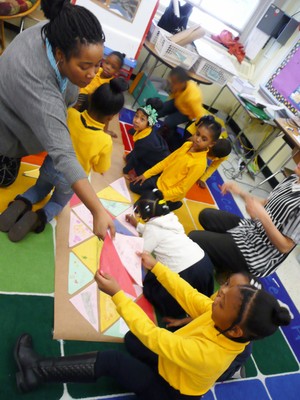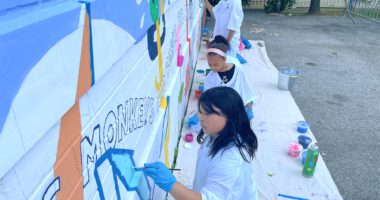Second period begins at 9:12am at PS 316 in Brooklyn and the students of this first grade visual arts and poetry class are always aware that it’s time for Community-Word Project. On our first visit, my partner and I were welcomed into a room where the students were more than a little rowdy and focused listening was hard to come by. Still, the students’ love for their opening ritual (a Maori chant called “The Breath of Life”), and for other CWP traditions such as playing Miss Mary Mack, is evident. My partner and I quickly learned that music is a great tool in regaining the group’s focus and as a tie-in to the lesson.

The benefits of scaffolding that program facilitators Patti Chilsen and Renée Watson taught us were quickly apparent as teaching artists Phyllis Capello and Felipe Galindo led the class in exercises that focused on writing riddles and incorporating sensory details and imagination into their writing. What was seemingly a fun exercise for the students was also an engaging lesson in noticing details and imagery in order to craft the perfect riddle. It is this, along with the combination of Phyllis and Felipe’s poetry, music, and visual art that have been essential to the growth in the students’ vocabularies, writing and visualizing skills. From the most gregarious of students to the shyest, there exists a multiplicity of voices in the room that is amazing to witness.
One of the most exciting moments to date was a recent exchange with a student. One of the more “active” bodies in the room, his attention is not easily won and he has been at the center of more than one class squabble. Still, we continued to work through visual imagery and poetry, and during one lesson Felipe said a few words to him in Spanish. The student quickly perked up and expressed his love of the language, leading us all to speak to him in both English and Spanish. During our most recent lesson he began including written Spanish in his artistic creations and was eager to show off his work — a near 180 degree conversion from previous lessons. Such a small discovery, and yet it has already led to a larger conversion.
And while there are still those who literally attempt to scale classroom walls, to see students newly engaged and impassioned is equally exciting for them as it is for us.

-Jehan Roberson, TATIP Trainee, Writer
CWP programming at PS 316 was made possible in part by The New York Community Trust.



